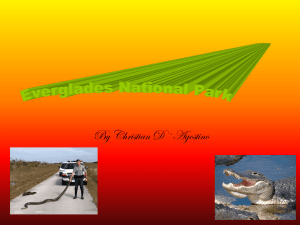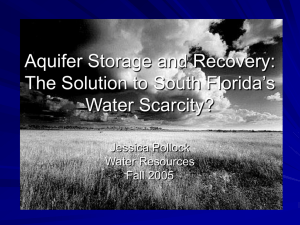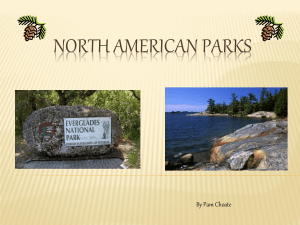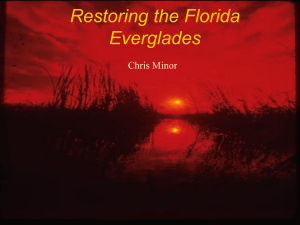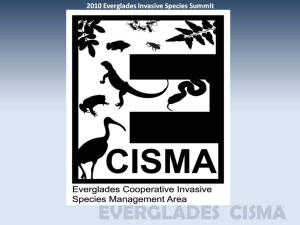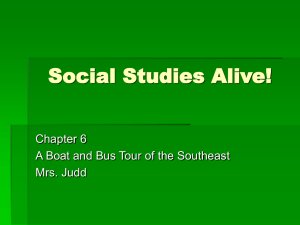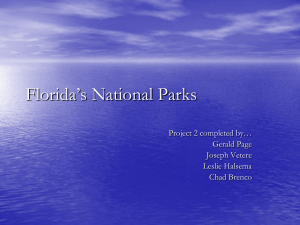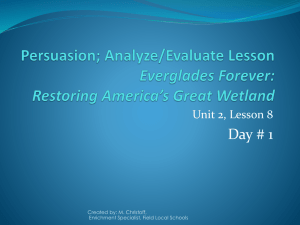Everglades_GROUP presentation_Sep22
advertisement
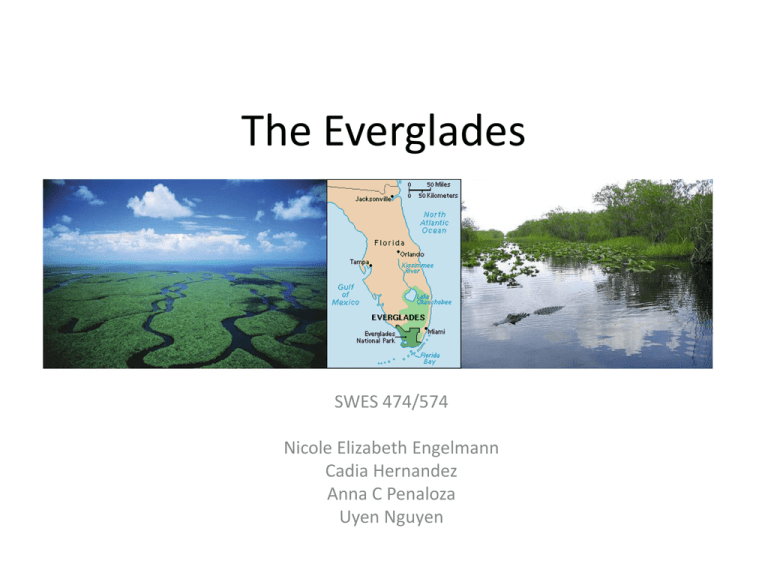
The Everglades SWES 474/574 Nicole Elizabeth Engelmann Cadia Hernandez Anna C Penaloza Uyen Nguyen Contents • • • • • • Background Terrestrial ecosystem Marine ecology and animals of the Everglades Historical and human development Restoration and management Conclusions Background • • • • • The Everglades, also called The River of Grass Covering 4,000 sq miles and extending from the Lake Okeechobee to South Florida Bay Everglades National Park is at downstream end of massive system of canals, levees, water control structures. The Everglades is a World Heritage Site and an International Reserve About half of the area has been lost to agriculture and urbanization Kissimmee River Lake Okeechobee The Everglades Florida Keys Facts • Consisting the largest wetlands located in the lower 48 states in the U.S.A • Supplying fresh water for > 6 millions people including Miami and surrounding regions of South Florida. • A sup-tropical climate enclosed with annual natural hazards such as drought, flood, fire. • The unique place on Earth exits both alligators and crocodiles. • Everglades restoration project is the largest environmental repair job in the history. Terrestrial ecosystem • Home of more than 350 species of birds, over a thousand species of wetland plants, trees, marsh vegetation, invertebrates, fresh and salt water fish, amphibians reptiles and mammals. • 67 threatened or endangered species. Everglades vegetation in cross section Source: Wikipedia Invasive species Examples • Plants: Brazilian pepper tree, Chinese privet, Punk tree, Australian Pine, Burma reed and Old World climbing fern. Invasive Species Examples • Animals: Burmese python, Cuban tree frog, Nile monitor, and wild boar. Seasonal Use • River Otter and Everglade Mink: • Highest frequency of use in swamp forests. Lowest frequency in fresh water marshes. • Highest frequency in the late wet season=mating season for both species Everglade birds in a eggshell • Wading Birds: 16 species within the everglades. Are heavily influenced by seasonal floods. Changes in water recession and flooding rates can cause widespread nest abandonment during breeding season. And constant water flow limitation limits food availability. • Land Birds: About 200 birds have been known to travel through the Everglades and reside in the drier parts of the park, as well as tree islands. These include warblers, meadowlarks, blue jays, cardinals, red bellied woodpeckers. • Birds of Prey: Includes the red shouldered hawk, barred owl, osprey, bald eagle, and the threatened snail kite. These birds are usually found in every everglade ecosystem. The Florida Panther • Endangered. Highly elusive. Thought to be extinct • 30-60 estimated animals left in the wild. • Habitat has been reduced to the Everglades National Park and National Preserve. • Requires large territories • Attempt at recovery through captive breeding Marine Ecology & Animals of the Everglades Florida Bay • Fresh water coming into the bay from the everglades creates perfect conditions for vast beds of turtle grass and algae formations. • Sea grasses also serve to stabilize the sea beds and protect shorelines from erosion by absorbing the waves. Manatees • Biggest single threat to West Indian manatees is death from collisions with recreational watercrafts. • Rebounded from endangered to threatened. Sea Turtles • Human development is a major threat to sea turtles. • They are important to their ecosystem due to their link to sea grass beds. Alligators/Crocodiles • Alligators are tied to hydrology, salinity and system productivity, all of which should be affected during restoration. • Crocodiles most significant threat is disturbance by people and is listed as vulnerable. Invasive Species • Blue Tilapia • Nile Monitor History and Human development in the Everglades • Area of the watershed is over 50,000 sq km • Human population: ~ 6.5millions and >85% people living along the Atlantic Coastal Ridge A Timeline of Human Development • 1000 B.C. – 1513 – The Calusa Indians lived in the Everglades before Spanish settlement. • 1700s – Seminoles and Miccosukee were forced to move to Southern Florida. • Late 1800s- The only settlements in the Everglades were: Chokoloskee, Cape Sable and Flamingo • 1850 – The Swamplands Act – Wetlands rights were transferred from the government to the state. • 1905 – 1910 – major dredging efforts • 1920s – canals, roads, and buildings built to accommodate visitors • 1947 – Everglades established as a national park – 1.3 Million Acres of land set aside • 1948 – Central and South Florida project - Army Corps of Engineers built roads, canals, levees, and water-control structures – Major Degradation in Land Area • 1962 – Channelization of Kissimmee River by Army Corps of Engineers – Destroyed 48,000 acres of wetland • 1963 – Central Everglades divided into 3 areas • 1967 - Florida panther, the snail kite, Cape Sable seaside sparrow placed on the endangered list. • 1971 – Disneyworld opens, Kissimmee River is straightened – Another 45,000 acres of floodplains lost • 1974 – Big Cypress National Preserve established • 1979 – Declared a World Heritage Site • 2001 – CERP plans passed in Congress POPULATION: 335,709 POPULATION: 238,300 POPULATION: 165,521 POPULATION: 399,457 AND COUNTING The Results of the Big Boom • The Everglades were disconnected from its natural flowing system, Kissimmee River, and Lake Okeechobee • 6.4 billion Liters of water that once went to the Everglades must now be diverted to the ocean. – Ocean is receiving too much freshwater, while estuaries are not receiving enough • Mercury, fertilizer, oil, and urban runoff now goes to the Everglades. • Human neglect of farmlands have lead to invasive species domination • 26% of the flora and fauna are exotic/invasive species • 14 native species are endangered and 9 are threatened So is it too late? Management and Restoration Plans • Comprehensive Everglades Restoration Plan (CERP) • Early Everglades Restoration Initiatives • Everglades Cooperative Invasive Species Management Area (CISMA) Why need good plans for management and Restoration in the Everglades? • It’s a wetland immense international importance, is threatened as a result of human manipulation for drainage and development. • The past management was only focused on issues associated with nutrient enrichment and disruption of regional hydrology. Temporal and spatial changes in soil total phosphorus content and cattail coverage in the northern Everglades. Sklar, F.H., Chimney, M.J., Newman, S., McCormick, P., Gawlik, D., Miao, ShiLi., McVoy, C., Said, W., Newman, J., Coronado, C., Crozier, G., Korvela, & Rutchey, K.2005. The ecological-social underpinnings of Everglades restoration. Front Ecol Environ, 3(3), 161-169. Comprehensive Everglades Restoration Plan (CERP) Objectives: CERP is expected to reverse negative environmental trends by “getting the water right”. How: This will produce ecological trade-offs and will require new and innovative scientific measures to: + reduce total phosphorus concentrations within the remaining marsh to 10 μg/L or lower. + quantify and link ecological benefits to the restoration of depths, hydro periods, and flow velocities. + compensate for ecological, economic, and hydrologic uncertainties in the CERP through adaptive management. http://www.evergladesplan.org/ Early Everglades Restoration Initiatives • Ecological Deterioration: predict salinity, increase marsh hydro periods, reduce coastal hyper salinity • Corrective Actions to Restore Hydrology: restore flows, reduce seepage flows , restore fresh water flows to the Florida Bay. http://www.evergladesplan.org Water Conveyance Features Tamiami Trail Bridging Buffers for Seepage Mgmt. and Flood Control http://www.nps.gov/ever/naturescience/cerp.htm Everglades Cooperative Invasive Species Management Area (CISMA) • Improving the effectiveness of invasive species control by sharing information, innovation and technology : by making list of priority plant/ animal, making Map, network. • Example: Rapid response to Lumnitzera racemosa (an Austral-Asian Mangrove Species) http://www.evergladescisma.org/ Conclusions • Terrestrial and marine plants and animals are continuously being affected by invasive species and development • Florida’s big boom has lead to the transformation of the land, including habitat loss and pollution • It is true that restoration works can never restore the Everglades to the real natural state. But it may be helpful steps in restoring habitat for many plants and animals in the ecosystem for survival. Thank you ! and Any Questions?
